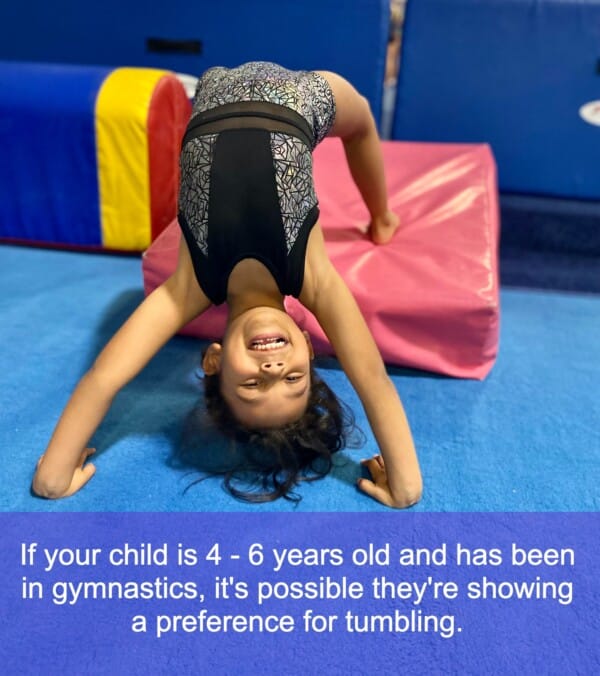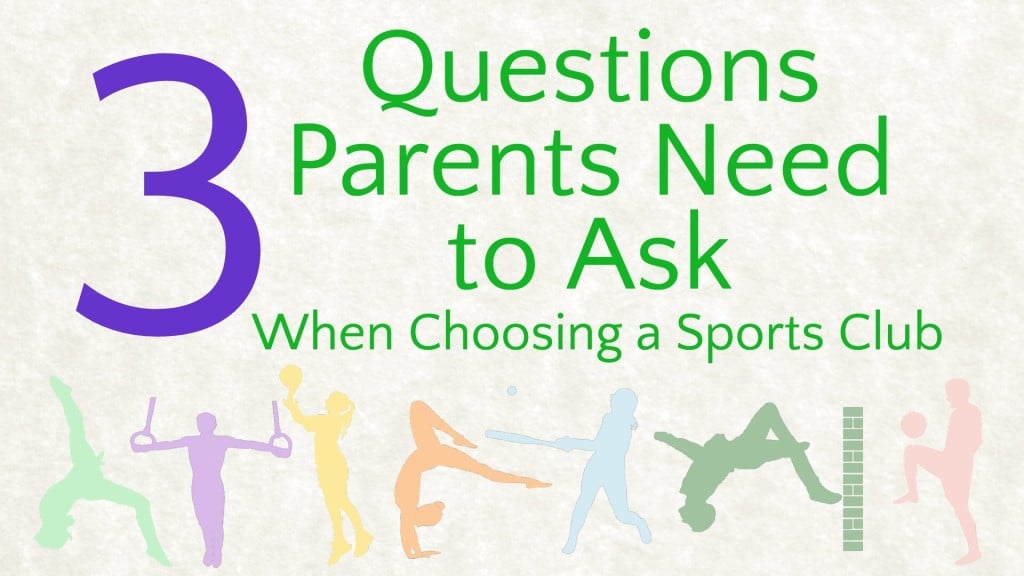Gymnastics or Tumbling? 3 Questions to Ask Before Choosing
Most young kids enjoy some form of tumbling. Rolling around the floor or outdoors is pretty typical. But maybe you have one of those kids who really loves bouncing and flipping on – or off – their bed. They seem to spend as much time upside down against a wall or on the couch as they do on their feet. You’re thinking about enrolling them in a gymnastics or tumbling class. But how do you choose between the two?
Hopefully, you will have an answer to that by the end of this article! But first, let’s look at some differences between the two.

Differences Between Gymnastics and Tumbling
What is gymnastics?
Gymnastics is a fun and challenging sport. It uses a variety of equipment upon which athletes perform both dance and acrobatic moves. It requires a tremendous amount of strength, flexibility, endurance, and coordination. Gymnasts must also develop a high level of focus and concentration as they perform skills with precision and grace.
Women’s artistic gymnastics is the most popular and a big favorite when watching the Olympics. It consists of four events: vault, uneven parallel bars, balance beam and floor exercise. Men’s gymnastics has six events: vault, parallel bars, high bar, pommel horse, still rings, and floor exercise.
All events require students to advance through a series of progressions. This assures they are adequately prepared for the next level.
Gymnastics also involves artistry. Athletes must perform routines with accuracy grace, and personal expression. Gymnastics can be either recreational or competitive.
What is tumbling?
Although there is tumbling in gymnastics, it is also recognized as a separate discipline within USA Gymnastics. USAG is the national governing body for gymnastics in the United States.
No equipment is needed for tumbling. All routines are done on a spring floor runway. It requires a great deal of power and precision. Competitors are judged on things like proper body position, speed, rhythm, and height. Check out this Men’s 2023 World Championship Finals video. Power on display!
The tumbling discipline of USAG includes levels 1 through 10. Level 1 begins with a handstand against the wall. Level 3 teaches how to do a back handspring. From there, more advanced skills like layouts and twists are taught. You can view the skills required at each level here.
It is not as popular as gymnastics. You may have to travel further for competitions if you decide to go the competitive route. But many gymnastics clubs offer tumbling classes for recreation. Cheerleaders, parkour enthusiasts, dancers, and street tumblers all benefit from such classes.
Now that you know a bit about the differences between tumbling and gymnastics, let’s talk about what’s the best choice for your child.
3 Questions to Ask Before Choosing Gymnastics or Tumbling
1. How old is your child?
This may be the only question you need to ask! Age plays a huge part in your decision making.
- Toddlers. From early walkers up to about the age of three, children are developing their gross motor skills. These include:
- learning to walk then run
- kicking a ball
- going up and down stairs alone
- jumping with two feet off the ground
- balancing on one foot
- riding a tricycle
These are basic skills beginning tumblers must have at a minimum. Many gyms offer tumbling classes for toddlers, but they are likely to be readiness classes. Even at Level 1 tumbling, a handstand against the wall, is out of reach for most toddlers – unless you have a gifted superstar!
Kids this age also must learn how to sit and listen, follow directions, and develop some hand-eye coordination. Their mental ability to process thoughts, perform basic problem solving, and remember things are also important skills they need before entering a beginning tumbling class.
Gymnastics classes for tots exposes them to all kinds of equipment. They focus on large muscle growth, balance, spatial awareness, and flexibility. They also help tots reach important mental and social milestones.
Most gyms begin with parent-tot classes. Once the toddler is familiar with the class structure, moving to the next class apart from a parent is the next step. Gymnastics, with its vast exposure to so much equipment to learn on is the ideal starting point for toddlers!
- 4 – 6 year olds. Kids in this age bracket are learning to:
-
- skip and hop on one foot
- jump rope
- catch a ball and throw it overhand
- balance on one foot for 10 seconds
- swing and climb
At this age, kids have developed enough strength, balance, and coordination to perform forward and backward rolls, cartwheels, and handstands. Some may be able to do more advanced skills as well. They also should be able to sit and listen to instructions and get along with others in group settings.
If your child has been in gymnastics, you may notice them showing a preference for tumbling more than the other events. Ask them what they like best about class. If it’s tumbling and the gym has a separate tumbling class for this age group, try it out. Many gyms, however, still keep this age in the readiness category and prefer to work on all the equipment.
If your child has been in gymnastics, it’s possible they’re showing a preference for tumbling. Or they may excel in tumbling more than the other events. Ask them what they like best about class. If it’s tumbling and the gym has a separate tumbling class for this age group, try it out. Many gyms, however, still keep this age in the readiness category and prefer to work on all the equipment.
If your child hasn’t been in gymnastics and the gym has both a gymnastics class and a tumbling class for this age group, talk to the staff. Take a trial class. They can assess your child’s abilities and suggest the best class.
- Ages 7 and up. At this age, kids are able to tell you what interests them most. Ask them! If they have reached expected milestones physically and emotionally, they are able to join either gymnastics or tumbling classes. A visit to the gym for a trial class or a phone call will help you make the right decision.

2. Where do your child’s interests lie?
Your child my be bouncing on their bed, pulling cushions off the couch for acrobatic stunts, and trying to walk on their hands. That doesn’t necessarily mean you should enroll them in tumbling right away. It could be their attempt to use what they have at home to practice their own version of gymnastics.
If your son or daughter has never taken a gymnastics class, which includes basic tumbling, that is the best place to start. They will be exposed to all events and develop strength, flexibility, spatial awareness, and more. These will better equip them for a single focus on tumbling.
Is your child already in a sport? Does he or she want to learn or perfect skills to get ahead? Then tumbling is a great choice. Many cheerleaders, dancers, parkour enthusiasts, and competitive gymnasts take tumbling classes in addition to their primary sport.
And let’s not forget those kids who just want to learn cool tricks! There’s nothing wrong with wanting to learn back handsprings, back tucks and aerials! It gives kids a confidence boost and helps them feel good about who they are. For those kids, tumbling classes are the right choice.
You can also search for private tumbling lessons near you. Schedule a few training sessions for your child if it will better prepare them for upcoming tryouts.
3. What are your fitness goals for your child?
Every parent wants a healthy, physically fit child. Unfortunately, times have changed drastically over the last few decades. Many kids spend the majority of their time sitting. Technology and the lure into the virtual world has robbed many kids of reaching fitness goals. Obesity is at all time highs as well as childhood diabetes and chronic illnesses.
If your only motive for registering your child in a fitness program is to get them moving and prepare them for a promising future, then kudos to you! Whatever the future holds for your kids, it cannot be achieved if they neglect their health and fitness.
Prioritizing physical activity for your kids gives them a huge advantage. Get them outdoors, playing on playgrounds and running with friends. Guard against handing them devices that stifle their growth – both in body and mind.
Gymnastics and tumbling are sports that build full body strength, improve balance and spatial awareness. They are excellent forms of preparation for almost any other sport boys and girls may choose to do later. They are also available year round and offer never-ending advancement possibilities. The confidence gained through hard work and achievement is invaluable.
If your fitness goals for your child include any of the above, start your toddler in a gymnastics class. As they advance through levels, they may decide to focus only on tumbling.
If your child is older, and their interests lie more in tumbling, sign them up! Whenever kids express an interest in physical fitness, parents should encourage them to pursue it.

SO…What Will It Be: Gymnastics or Tumbling?
Ultimately, the decision lies with you, the parent. You know your child best. Our recommendation is to start with gymnastics if you have a toddler or young preschooler. Gymnastics will give them a solid foundation of basic skill development and introduce them to group dynamics. They will be exposed to plenty of tumbling and can choose later if they want to make that their sole focus.
If your child is older or wants to enhance tumbling skills for a current sport, then tumbling should be considered. Remember, you can always schedule a trial class and talk to the staff to get their input.
* * * * * * *
EmethGym offers free trials for both gymnastics and tumbling. Kids get to participate in a full class while you watch. You’ll have a chance to talk to a coach or staff member to ask any questions you have.
Whatever you choose, it’s important to get your kids physically active as young as possible. Good habits formed while young greatly increase the chance your child will lead a long, happy, successful life.


